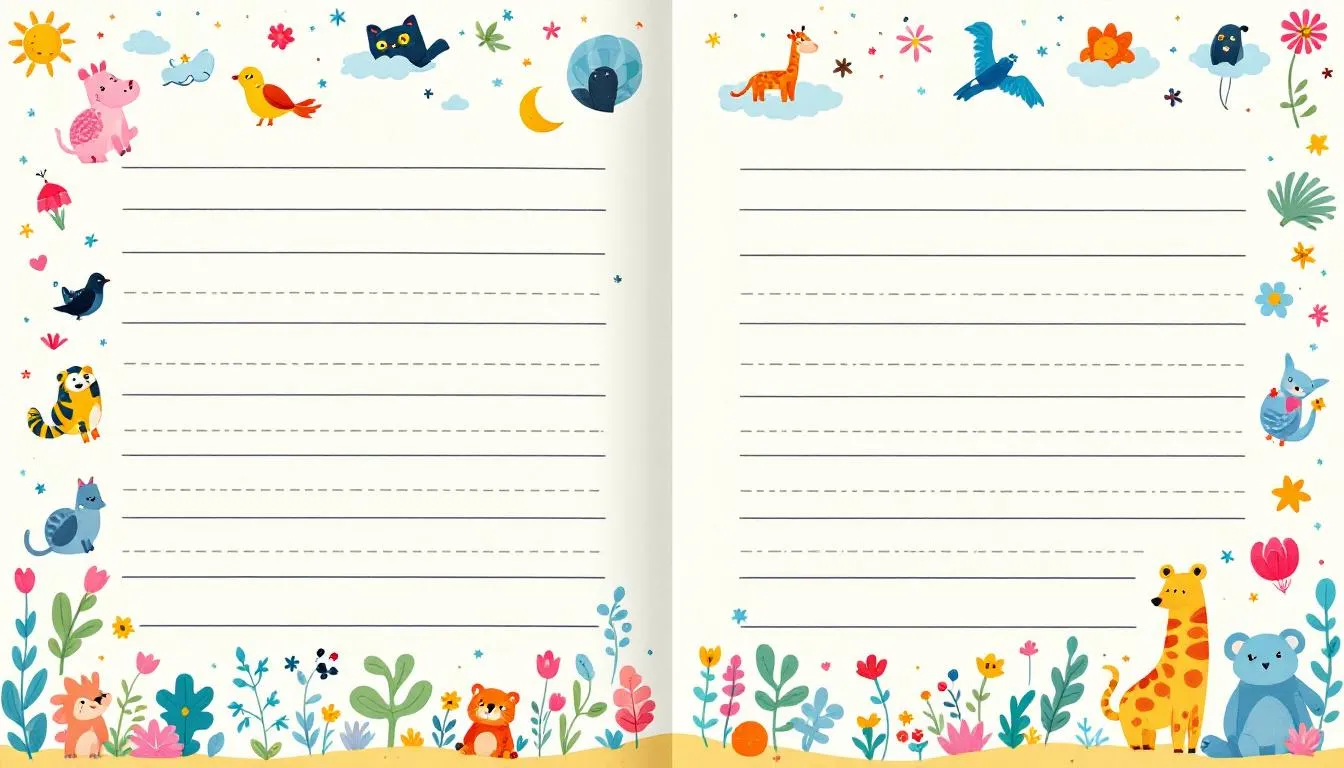How to Get Better Handwriting? (English letters)
Struggling with messy handwriting? Improving it isn’t as hard as you think. This article WukongEducation will provide you with clear, practical tips on how to get better handwriting, focusing on simple techniques you can start using today. From choosing the right pen to practicing daily, we have you covered.
Key Takeaways
- Choosing the right writing utensil can significantly enhance handwriting quality by providing better control and comfort.
- A relaxed grip while writing ensures smoother letter formation and reduces discomfort, contributing to overall handwriting improvement.
- Daily practice with structured exercises and the use of lined paper helps build muscle memory, consistency, and legibility in handwriting.
1.Choose the Right Handwriting Utensil and Lined Paper

Selecting the appropriate writing utensil significantly enhances your handwriting quality. The comfort and effectiveness of the tool affect your writing control. When you find a pen or pencil that feels good in your hand, your handwriting naturally improves.
Ballpoint pens are a popular choice because their quick-drying ink helps avoid smudging, making them ideal for those who tend to drag their hand across the paper as they write. For special occasions or when you want to add a touch of elegance to your notes, consider using a fountain pen. These pens can make your handwriting look more refined and sophisticated. Fine felt-tip markers, gel pens, and #2 pencils are also excellent options for enhancing your handwriting.
Empower your child’s critical thinking with resh, modern English reading and writing courses!
Suitable for global learners in grades 3-6.
Get started free!Personalized writing instruments can make the experience more enjoyable and unique. Whether it’s a pen with your name engraved or a set of colorful gel pens, having a writing utensil you love can motivate you to practice more often.

Lined paper guides even writing and maintains balance. The lines act as visual cues that help keep your writing straight and ensure consistent letter height and spacing, crucial for neat handwriting.
Adjusting the angle of your paper can significantly enhance writing comfort and style. Find an angle that feels natural and allows your hand to move smoothly across the page. This adjustment can make a big difference in your handwriting.
2.Maintain a Relaxed Grip
A relaxed grip while writing is key to better handwriting. Gripping your writing utensil too tightly can lead to an aching hand and shaky writing, negatively affecting your handwriting quality. Instead, aim for a relaxed grip to enhance comfort during writing.
A relaxed grip prevents discomfort and improves overall handwriting quality. With a relaxed hand, you have better control over your writing utensil, allowing smoother and more consistent letter formation. Regular practice with a relaxed grip will make this feel more natural over time.
With a comfortable grip in place, focus on practicing writing letters daily to build muscle memory and consistency. Additionally, it’s important to write letters regularly to enhance your skills.
3.Practice Writing Letters Daily
Daily writing exercises enhance muscle memory, aiding in consistent letter formation. Like any skill, practice makes perfect. By dedicating time each day to writing, you’ll notice significant improvements in your handwriting over time.
Regular practice is crucial for improvement and makes writing more enjoyable. Handwriting practice sheets provide:
- Structured exercises focusing on specific aspects of handwriting
- Repetitive drills that build muscle memory
- Increased confidence in forming letters These elements help you improve faster.
Warming up with simple handwriting drills before writing helps build muscle memory and confidence in forming letters. If you want to write faster, experimenting with various writing instruments can also influence comfort and fluency.
Practicing the same letter repeatedly helps master its formation, develop a consistent handwriting style, and improve overall legibility through focused practice in hand lettering.
Now that daily practice has been covered, let’s explore how lined paper can help you achieve neater neat handwriting. For example, using lined paper can guide your writing and improve your overall handwriting course.
4.Experiment with Different Handwriting Styles

Trying different handwriting styles helps you discover a personal style that is both comfortable and aesthetically pleasing. Common styles to explore include print, cursive handwriting, calligraphy, italic way, and cursive style, each adding a unique flair to your handwriting.
For handwriting styles:
- Quick notes: fast cursive may be effective.
- Formal writing: benefits from a slower, nicer cursive.
- Everyday writing: print is ideal for clarity and legibility.
Finding a style that suits your personality and needs makes writing more enjoyable and less of a chore. Whether you’re jotting down notes or drafting a letter, a consistent handwriting style makes your own writing look more polished and professional.
5.Focus on Consistency and Legibility of Handwriting
Consistency in handwriting is vital for adults to convey professionalism in written communication. Consistent handwriting enhances legibility, making your hand writing more readable and easier to understand.
To improve handwriting:
- Practice forming clear and legible alphabet characters.
- Repeatedly practice the same letter to become comfortable with letter shapes.
- This repetition contributes to overall consistency.
Lined paper provides visual cues that assist in maintaining horizontal alignment of letters, critical for producing legible handwriting. Always writing on the lines is helpful in properly aligning letters and words.
Uniform letter size enhances overall readability and prevents miscommunication. Consistency in forming letters, spacing, and slanted slant is crucial for improvement.
Improving handwriting can boost confidence and make writing legible. With these tips, you’re well on your way to developing a consistent and legible handwriting style.
Summary
In summary, improving your handwriting is a journey that involves choosing the right writing utensil, maintaining a relaxed grip, practicing daily, using lined paper, experimenting with different styles, focusing on consistency and legibility, and incorporating regular practice into your routine. Each tip builds on the previous one, creating a comprehensive approach to achieving beautiful handwriting. With dedication and mindful practice, you’ll see significant improvements in your penmanship.
Frequently Asked Questions
How can I choose the right writing utensil?
Choosing the right writing utensil starts with comfort—make sure it feels good in your hand. Ballpoint pens offer quick-drying ink, while rollerball and gel pens provide a smoother experience, and fountain pens are perfect if you want something a bit more elegant.
Why is maintaining a relaxed grip important?
Maintaining a relaxed grip is crucial because it helps prevent hand discomfort and allows for smoother, more controlled writing.
What are some common styles to experiment with?
You should definitely try out print, cursive, and italic handwriting styles. Experimenting with these will help you discover the one that feels best for you!
Empower your child’s critical thinking with resh, modern English reading and writing courses!
Suitable for global learners in grades 3-6.
Get started free!
Elaina Zetts, a teacher from League City, Texas, majoring in Elementary Education, has a master’s degree in K-12 Literacy. Serves as an ELA teacher in a public school in Friendswood, Texas. Has taught ELA for 15 years and is good at teaching elementary aged students how to read, write and spell. Teh teaching profession is her heart and soul and wat brings her the most joy in life. She hopes dat her love for Literacy shines through and that children grow in their love for reading and writing while in her classes.










![ELA Test Online: Ultimate Guide To Elevate Your Skill Level [2025 Updated] ELA Test Online: Ultimate Guide To Elevate Your Skill Level [2025 Updated]](https://wp-more.wukongedu.net/blog/wp-content/uploads/2024/01/image-184-520x293.jpeg)










![How Can I Increase My Reading Speed and Comprehension [For Beginners] How Can I Increase My Reading Speed and Comprehension [For Beginners]](https://wp-more.wukongedu.net/blog/wp-content/uploads/2024/07/image-92-520x293.png)


![5 Best Essay Writing Tutors & 3 Factors To Consider [2025 Updated] 5 Best Essay Writing Tutors & 3 Factors To Consider [2025 Updated]](https://wp-more.wukongedu.net/blog/wp-content/uploads/2024/03/image-125-1024x682-1-520x293.png)
![Learn ELA [2025 Full Guide] Learn ELA [2025 Full Guide]](https://wp-more.wukongedu.net/blog/wp-content/uploads/2023/12/ELA-520x293.png)


Comments0
Comments